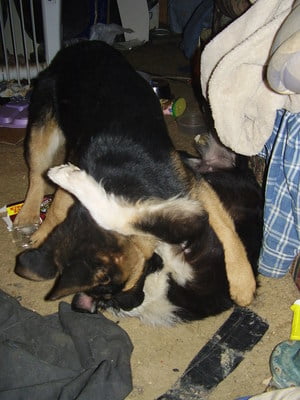A healthy dog is beautiful. It’s easy to recognize and although many see beauty in the carefully combed show dogs others see it in the movement of a border collie circling a flock of sheep, or a whippet running after a lure or a coonhound baying as he stretches up the tree. They have a need for function as well as pretty and truly it’s function as well as physical condition that makes a dog *healthy* in the opinion of many.
A healthy dog shines with a beautiful coat, even if it’s short. The eyes sparkle, the teeth gleam and the dog moves effortlessly across the yard. He can perform the duties that his breed was developed to do if he had to. While, sadly, there are many genetic issues in dogs today, a good care program can minimize many things.
The kind of food is a heated topic and one that grew more heated with the recall of so many brands of dog food this spring. For years many avidly supported Science Diet or Eukanuba and looked down at those who fed lesser brands. Purina has avid customers via their “ProPlan” club. Still others shun kibble totally. Lesser known brands of food like Bil-Jac have a steady base of customers. There are many who cook for their dogs and still many more who have seen major differences after changing to a raw diet. And it seems each one has a list of fans and critics, healthy and unhealthy dogs. It seems to illustrate two things – that dogs can be incredibly adaptable and also can be so sadly fragile.
Whatever type of dog food you use – digestibility matters. Many experts cite stool quality and volume – small firm stools show more nutrition is being used by the dog and less being processed as waste. This is key no matter the cost – because the dog shouldn’t be a manure factory. Using the food to get nutrition to the heart, lungs, liver, joints and other systems is a sign of a functioning, healthy system. The use of poor quality ingredients or fillers affects digestibility with runny or mushy stools. Even good ingredients can be less effective if over cooked or over processed. These are signs only the owner is likely to know – and be able to influence.
Body condition is a factor – a general guide is being able to feel but not see the ribs. There should be a rise in the belly behind the ribs (except for pregnant females) and ribs shouldn’t be visible but easily felt. Too thin isn’t good but nor is too fat. There are far too many obese pets now – with a rise in problems that were not common in years past including diabetes.
A healthy dog has skin that is smooth, pliable and free from dandruff and odor. The color might range depending on breed but a clean coat and clear, bright eyes free of discharge are undeniable signs of health. A sleek, shiny coat with clear, bright eyes is a clear sign he’s feeling good. He should carry himself alertly, and not have difficulty breathing. Healthy pink gums with white, not yellowed or off color, teeth are a good sign. These are outward signs of another sign of health – a healthy immune system. A dog who is healthy resists disease better, is less likely to get sick. Swollen gums and unhealthy teeth can often be improved with healthy things to chew on. There are toothbrushes and toothpaste available now but raw food supporters cite chewing bones as eliminating the build up that affect dogs fed kibble.
Bone and joint health is important in health. They need protein, water and minerals. While we can’t see bones we can see signs of problems. A dog with a normal range of motion and flexibility is important. They’re able to climb stairs, jump and play; and their posture and stance shows proper weight on all four feet. They’re interested in play or doing something.
Additionally attitude comes in. When we don’t feel well often the attitude is poor – and attitude is a key indicator in pets too, who can’t speak. The difference in a robust, sleek Doberman running across the pen with a buddy, playing and wrestling and the dog sitting on the porch, ears down, obviously not feeling well is cler to see. So often the extremes are easy to see but the in between isn’t so much so. Knowing your dog is important. Is he normally a little territorial about his food? Does he normally eat it big gulps (something that should be addressed) or does he eat daintily, with each piece of food chewed? Does he normally clean up his bowl in 15 minutes or does he leave a little to come back in an hour and finish? These things help define his normal. When it changes you have your first clue something isn’t right. If for five years your dog clears up his meal, licks the bowl clean, comes for his goodie then lays on his bed for the morning you have his normal. When he comes in and eats half a bowl then goes and lays down – you have your first indication something isn’t right probably long before he gets SICK. While training can modify many behaviors and certainly should be done, the dog’s general attitude is noteworthy for health too.
Pay attention to your dog. Observe the little things he or she does as normal. It may save his life.



